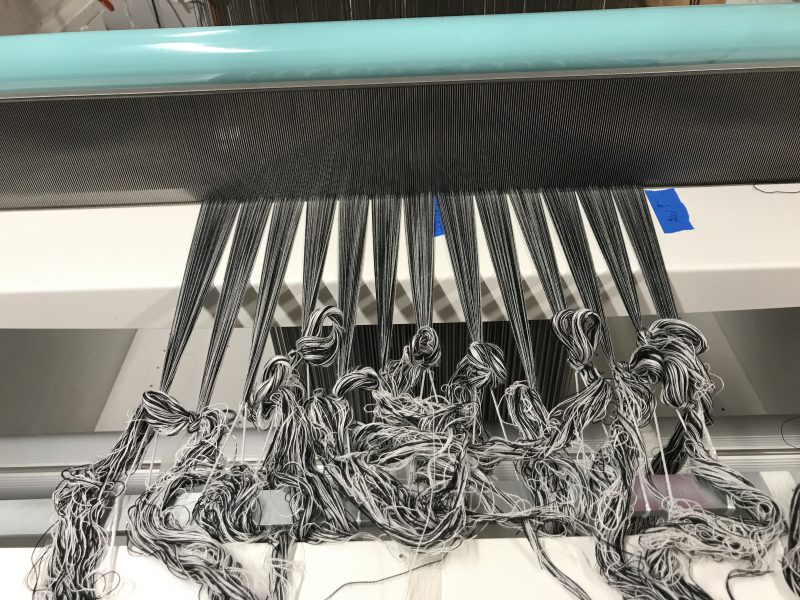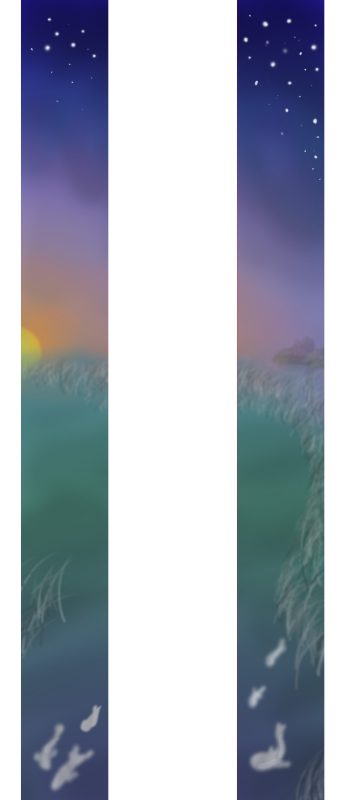Yesterday I worked for nine obsessive hours getting Amazing Grace ready to weave, culminating in this thrilling sight:

The warp is theoretically ready to weave, but in practice the next phase is debugging, which I expect to take a week or so. Debugging means finding all the broken threads, loose threads, sticky heddles, etc. and fixing them. For me, debugging is usually the most frustrating part of warping because I am so so so close to being able to weave, but countless small problems prevent forward progress. This time, however, I’m so excited about the prospect of Actual Weaving that I think it will go quickly.
Finishing the warping means that I need to start thinking about what to weave. The next piece is going to be a commission – a stole for Everett, who is training as a Unitarian minister and wants a stole for his eventual ordination. This is a very special occasion, calling for a very special piece. And I aim to deliver.
Back in January, Everett and I came up with this sketch:

The design will actually be divided in half when worn, one half around each side of the neck. It will look like this:

I’ve been thinking hard about the logistics of creating the stole. The first step is to figure out what colors I’ll be working with, and the overall structure. There are a lot of subtle shades in this piece, but it looks like I can create them all using mixes of eight weft colors: indigo blue, teal forest green, medium green, gold, orange, dusty lavender, and metallic silver. (I may throw in some navy blue at the very top, but haven’t decided yet.) I’ll be using four colors at any given time, rotating colors in and out as appropriate and interlacing them with a black warp. That will enable me to create a piece with literally hundreds of colors.
The warp is silk, alternating black and white, and is about 25% finer than sewing thread (for any weavers reading, that’s 60/2 silk). It’s sett at 120 ends per inch, suitable for double weave. I’m actually weaving the piece in two layers – the top layer weaving with the black warp, and the bottom layer weaving with the white one. The white layer will not show at all in the finished piece – its only purpose is to stabilize the wefts that are not being used.
I am mentally laying out the process for developing this piece. It involves developing hundreds of color combinations, and each color combination requires creating a separate weave structure. It also requires selecting, dyeing, and weaving samples with the hundreds of weave structures and all eight weft colors. Then I need to do some Photoshop work to convert the image into something weave-able. After that, I’ll weave selected parts of the design and make adjustments as needed – and I expect there will be quite a few of them. Finally, I’ll be able to weave the finished cloth.
And then, after that, I’ll be ready to make some muslins for the stole and sew the finished piece. While I’ll be careful, of course, I’m not that worried about screwing up – 90% of the time in this piece is in developing the design, not weaving it, so if I screw up I can re-weave the fabric in just a few days’ work. I’m estimating 15-20 hours to weave (for the weavers, that’s 12,000 picks), but that is dwarfed by the time spent designing and weaving samples.
Since this is only my second commission, I’m keeping a time sheet for the piece – so I can figure out what I’m actually earning per hour while creating it. Then I can adjust my rates for future work appropriately. (Given all the work involved, I suspect Everett will be getting a pretty good deal!)

this will be stunning.
When you finish and analyze your time spent, consider that you will probably get faster at the sampling (and that you can use samples from previous projects) and also faster at the debugging. You may also figure out ways to reduce the amounts of “bugs” as you lay down the first warp. That wasn’t the world’s best sentence! I mean that you should consider this when you figure out how to charge for the time spent.
I remember that the first watch cap I crocheted, took about 10 times longer than the next one. And that my ultimate speed was again reduced as I became more familiar with the process. I could fairly charge about $7.50 for each cap at this point. (I donate them so the value is only for tax estimates.)
Show pictures of your process, please! This is fascinating. I would like to see some of your samples. And what do you do with the sample fabric you generate?
You accomplish what the rest of us only think about doing!! Well done.
True that I will probably get faster! Hopefully I can develop a sample collection that can simply be reused.
Samples generally go into a baggie and get tossed into a box. I rarely reuse them because I don’t often use the same colors twice…
And there will definitely be LOTS of pix of the process!
Hi Tien
About 20 years ago when my oldest friend was being ordained, and I knew a lot less about weaving than I do now, I offered to weave a stole for her. I used 10/2 mercerised cotton, designed a panel of trees for each end and wove them in Theo Moorman on a plain weave background. I copied the design on to plastic film and flipped it to match the ends. All things considered it turned out quite well and I know she uses it – she said the best thing about it was that it was light(I didn’t line it) and it stayed put, as a handwoven scarf often does, so she could get on with running her service rather than trying to keep it in place, as she had to do with a heavier one she’d had made
What I found most difficult was getting the mitre at the back right and and after I attended her ordination and saw lots of different stoles being worn, realised that it was because there is a lot of variation in the way shoulders slope. The mitre is not 45 degrees but whatever dart/angle is needed to account for the slope of the shoulders, maybe not the same on each side, so that the front panels hang straight.
If I were doing it again, I would find some fabric of similar weight and make a fabric pattern using the recipients shoulders to get it just right. If you had a personalised pattern for Everett then you might be able to design the back part so that it works well with the angle required, possibly disguising the join in the design
I found Joyce Harter’s books useful as well
Hope this helps, I found it a really rewarding experience, good luck
Helen
Thanks for the advice! I am planning on doing some muslins and sending them to him to check the fit. I will be careful to get the shoulder fit right!
Oh, my! Lucky Everett! Your work is mind boggling and beautiful. Thank you for sharing, and i look forward to your book!
Kind Regards, Cynthia t
I am anxious to see this as you work on it. It’s a great design. Someday, I will learn to weave. Now, I’m happy with shearing my goats, carding, spinning and dyeing the resulting yarns.
Fortunately, the recipient can see that he’s getting an extraordinary deal, and may be able to add an unofficial tip to the agreed-upon price…
Or alternatively, he can say “I was hoping you would do it for the exposure” and then flee the resulting barrage of shuttles and sharpened drop-spindles…
Thanks, Everett! But nope, a price is a price…I couldn’t possibly charge you more on top of what I quoted you. 🙂 I hope you like it!
I feel your pain! That is one reason I have only used a solid black warp – that way, I don’t have to re-thread and re-sley (with all the concomitant errors). This practice may limit my choice of imagery and weave structures, but it is much better for my mood and my health…